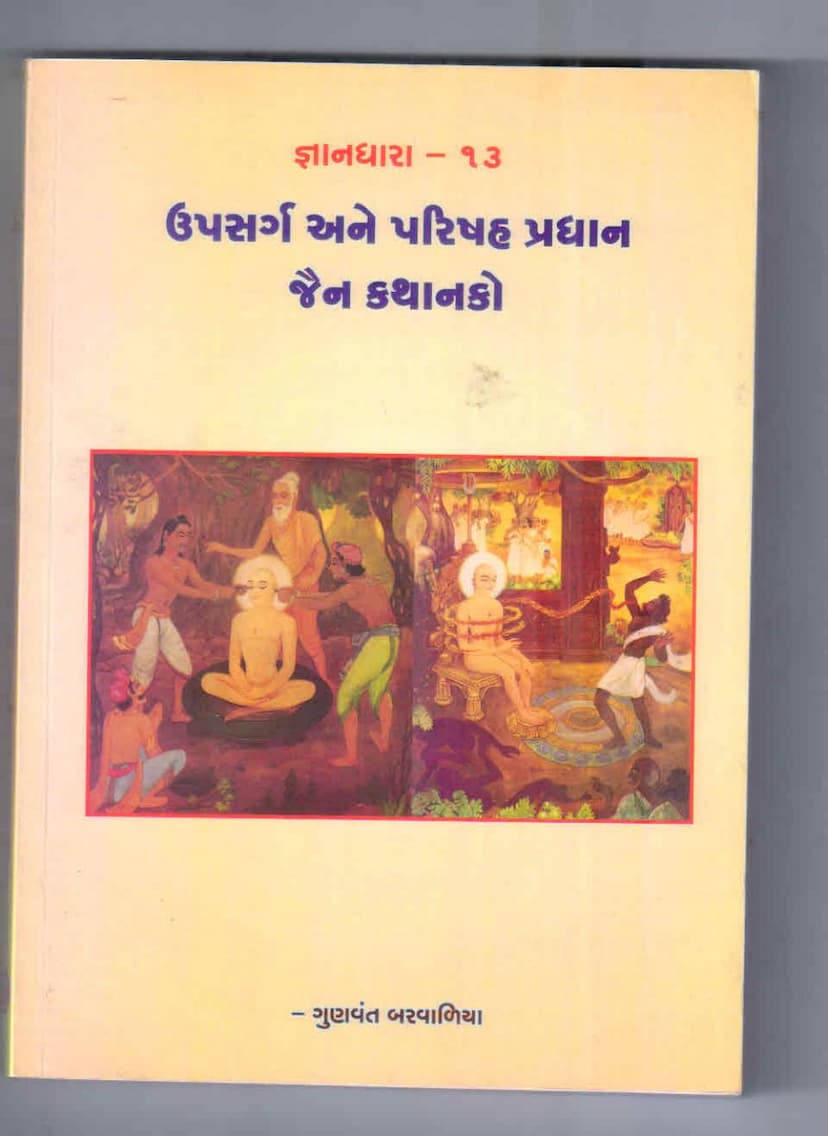Upsarg Ane Parishah Pradhan Jain Kathanak
Added to library: September 2, 2025

Summary
Certainly, here's a comprehensive summary of the Jain text "Upsarg Ane Parishah Pradhan Jain Kathanak" based on the provided content:
Book Title: Upsarg Ane Parishah Pradhan Jain Kathanako (Stories Centered on Trials and Tribulations) Author: Gunvant Barvalia (Editor) Publisher: Arham Spiritual Centre
Overall Theme: This book is a collection of Jain stories that highlight the concepts of 'Upsarg' (external adversities, afflictions, or troubles caused by divine beings, humans, or animals) and 'Parishah' (internal or external hardships and self-imposed austerities or trials faced by ascetics). The core message of these stories is the importance of enduring these difficulties with equanimity, detachment, and spiritual fortitude to achieve liberation (moksha).
Key Concepts Explained:
-
Upsarg: Defined as severe afflictions that can even lead to death. These are categorized into:
- Devakrut: Caused by divine beings (celestial beings).
- Manushyakrut: Caused by humans.
- Tiriyanchakrut: Caused by animals or creatures.
- Atmasanvedaniya: Internal suffering arising from one's own karma, particularly severe illnesses or mental distress. The book elaborates on subdivisions within these categories, such as those caused by attachment, hatred, delusion, or mere testing.
-
Parishah: Explained as hardships that a practitioner must endure to remain steadfast on the path of spiritual discipline and to shed karma. The book lists all 22 types of Parishah as described in Jain scriptures, including:
- Hunger (Kshudha)
- Thirst (Trusha)
- Cold (Sheet)
- Heat (Ushna)
- Insect bites (Dansh)
- Lack of clothing (Aklay)
- Discontent (Arati)
- Women (Stree)
- Wandering (Charya)
- Discomfort in lodging (Nishudya)
- Sitting/Sleeping discomfort (Shaiya)
- Abusive language (Akrosh)
- Physical violence (Vadh)
- Begging (Yachana)
- Lack of desired outcome (Alabh)
- Illness (Rog)
- Discomfort from grass/thorns (Trunsparsh)
- Dirt/Filth (Mal)
- Respect/Disrespect (Satkar-Puraskar)
- Knowledge (Pragna)
- Lack of knowledge (Agnan)
- Right Faith/Perception (Darshan)
Central Argument: The book emphasizes that these adversities (Upsarg and Parishah) are not obstacles to be avoided but rather opportunities for spiritual growth and karma reduction. By facing them with equanimity, the aspirant can purify their soul and progress towards liberation. The stories illustrate how even powerful individuals, saints, and devoted laypersons encountered severe trials but emerged victorious through their adherence to Jain principles and practices.
Content Highlights (Summarized from individual stories):
The book is structured into various narratives contributed by different authors, each focusing on specific figures and their struggles with Upsarg and Parishah:
- Pujya Manakchandji M.S.A. and Upsarg: Narrates the experiences of Pujya Manakchandji M.S.A. during a severe flood and an encounter with a hostile individual, highlighting his equanimity.
- Dhandhan Muni's Alabh Parishah: Details how Muni Dhandhan, despite facing prolonged lack of alms (Alabh Parishah) due to past karma, maintained his spiritual practice and achieved enlightenment.
- Tapasvi Jaychandji M.S.A. and Pujya Manakchandji M.S.A.'s Upsarg & Krutāradhikā Pujya Lilambai M.S.'s Rog Parishah: This section covers experiences of two ascetics facing divine and other afflictions, and Pujya Lilambai's mastery over Rog Parishah (illness).
- Sagarachandra's Story (Becoming an Exemplary Layperson): Recounts the tale of Sagarachandra, who faced challenges related to desire and societal norms, ultimately finding spiritual grounding.
- Arjun Mali's Story: Illustrates how Arjun Mali, after committing grave sins, found redemption and spiritual progress by enduring severe adversities and practicing penance.
- Acharya Kalak's Valor Story: Details the heroic actions of Acharya Kalak in defending Jain principles and rescuing a nun, showcasing courage and strategic thinking in the face of human-induced Upsarg.
- Sadhvi Ratna Pujya Hirabai M.S. and Pradeshin Raja's Story: Discusses the endurance of Sadhvi Hirabai and the transformation of King Pradeshin after encountering spiritual guidance.
- Vishalya and Mahashatak's Story: Highlights the strength and spiritual resilience of Vishalya and Mahashatak.
- Kadrūpo Nandishana and Metaraj Muni's Story: Focuses on overcoming physical imperfections (Nandishana) and enduring harsh situations (Metaraj Muni).
- Dadhivarya Muni's Tale: Details the severe trials faced by Muni Dadhivarya and his steadfastness.
- Acharya Gulabchandji Swami: Narrates the experiences of Acharya Gulabchandji, likely involving enduring Parishah like harsh weather and verbal abuse.
- Skandacharya's Story: Presents the trials and spiritual perseverance of Skandacharya.
- Sukumal and Shridatta Muni's Story: Explores the challenges faced by Sukumal and Shridatta Muni, emphasizing inner strength.
- Sati Chandana and Chilati Putra's Story: Covers the trials of Sati Chandana and the story of Chilati Putra.
- Aryarakshit Suri, Skandakumar, and Subhadra's Story: Discusses the spiritual journeys and adversities of Aryarakshit Suri, Skandakumar, and Subhadra.
- Sangamacharya and Sukoshal Muni's Story: Narrates the experiences of Sangamacharya and Sukoshal Muni.
- Sthulibhadra and Kurgadu Muni's Story: Highlights Sthulibhadra's mastery over certain Parishahs and his lapse in others, and Kurgadu Muni's experience with Akrosh Parishah.
- Kadrupo Nandishana and Metarja Muni's Story: Focuses on overcoming physical ugliness and enduring hardships.
- Sunanda Shravak's Story: Illustrates how a layperson, Sunanda, dealt with afflictions.
- Arjun Mali's Story: A story of redemption and enduring trials.
- Somdatt, Somdev, and Udayan Rajarshi's Story: Details the hardships faced by these figures and their spiritual responses.
- Darshan Parishah on Acharya Ashadabhuti's Story: Discusses doubt and overcoming it through spiritual insight.
Editorial Stance: The editor, Gunvant Barvalia, expresses joy in presenting these research papers as a collection. He highlights the importance of storytelling in Jainism, particularly through 'Kathanuyog' (the tradition of narrative discourse), as a means to convey profound philosophical concepts to the general populace. The book aims to showcase the vast treasure of Jain narratives that inspire moral conduct and spiritual aspiration.
Significance: The book serves as an important resource for understanding the practical application of Jain philosophy in the face of life's challenges. It demonstrates how individuals, through unwavering faith and adherence to spiritual principles, can transcend adversity and move towards ultimate liberation. The diverse stories offer lessons on patience, courage, detachment, forgiveness, and the profound power of inner strength and devotion.